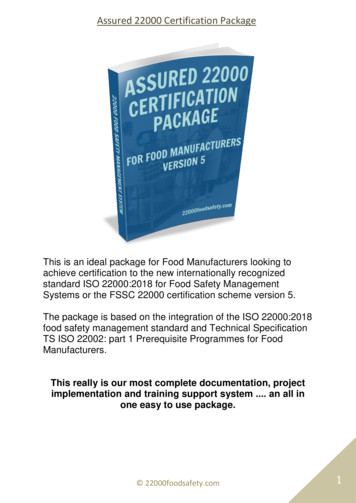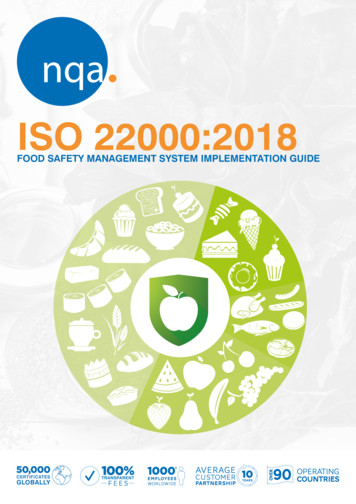ISO 22000:2018 FOOD SAFETY MANAGEMENT SYSTEMS .
ISO 22000:2018 FOOD SAFETY MANAGEMENTSYSTEMS IMPLEMENTATION GUIDEinfo@riskza.com www.riskza.com 0861 RISK ZA 28 Siphosethu Road, Mt. Edgecombe, KZN
ISO 22000:2018 Food Safety Management Systems Implementation GuideCONTENTSHOW ISO 22000:2018 WORKS 3SUMMARY OF CORE CONCEPTS OF ISO 22000:2018 5ISO 22000:2018 KEY REQUIREMENTS 66 TIPS FOR IMPLEMENTING AN EFFECTIVE FSMS 7HOW TO IMPLEMENT A FSMS 8 Risk ZA Corporate Sustainability (PTY) Ltd.Page 2
ISO 22000:2018 Food Safety Management Systems Implementation GuideHOW ISO 22000:2018 WORKSINTRODUCTIONThe World Health Organization estimates that one in 10 people fall ill and 420 000 people die dueto food poisoning every year. The prevalence of food contamination in Africa is particularly high,which makes food safety an important health concern, and improving food safety in the entiresupply chain imperative. ISO 22000:2018 aims to prevent hazards, and improve the safety andintegrity of the food supply system by applying tried and tested, internationally accepted foodcontamination control methods.ISO 22000:2018 combines the Plan-Do-Check-Act (PDCA) method and risk-based thinking withthe Hazard Analysis and Critical Control Point (HACCP) system to identify, prevent and controlfood safety hazards. Organisational and operational risk management is integrated into onemanagement system. The risk approach is intended to be a preventive tool that ensures theintegrity of the food management system. Organisations may choose to use other more extensiverisk management methods through the application of standards such as the ISO 31000:2018 RiskManagement Standard to make the FSMS more robust.A key difference between the 2005 and 2018 version of the standard is Annex SL, the managementframework for all revised ISO standards, which simplifies the integration of ISO managementsystems.WHICH BUSINESSES WILL BENEFIT FROM A FOOD SAFETY MANAGEMENTSYSTEM?The ISO 22000:2018 food safety management system (FSMS) can be applied by small, mediumand large food organisations in all areas of the food chain to improve food safety: Food and ingredient manufacturers Retailers Wholesalers Agricultural producers Transport,logistics and warehouses Equipment and packaging manufacturers Restaurants Caterers Risk ZA Corporate Sustainability (PTY) Ltd.Page3
ISO 22000:2018 Food Safety Management Systems Implementation GuideCombining risk-based thinking and the process approach helps to: Focus the FSMS and its activities on higher-risk processes and opportunities Provide an understanding of how processes in the organisation are interdependent Allow for effective use of resources Offer flexibility in order to meet customer requirements on an ongoing basisHACCP PRINCIPLESISO 22000:2018 combines the Plan-Do-Check-Act (PDCA) method and risk-based thinking withthe Hazard Analysis Control Plan (HACCP) system to identify, prevent and control food safetyhazards.Conduct rificationproceduresDeterminethe allimit(s)Estabish amonitoringsystemORGANISATIONAL PLANNING AND CONTROLThe Clauses of the ISO 22000:2018 standard can be used in the various phases of the Plan-DoCheck-Act (PDCA) method as follows:4. Context of the organisation5. Leadership6. Planning7. Support (including control ofexternally provided processes,products or services)8. Operation9. Performanceevaluation10. Improvement Risk ZA Corporate Sustainability (PTY) Ltd.Page4
ISO 22000:2018 Food Safety Management Systems Implementation GuideOPERATIONAL PLANNING AND CONTROLPRPsHazardanalysisTraceability systemValidationof controlmeasuresHazard controlplan (HACCP /OPRP plan)VerificationplanningEmergency preparedness & responseUpdating of preliminaryinformation and documentsspecifying the PRPs and thehazard control planVerification activitiesImplementation of the PlanControl of monitoringand measuringAnalysis of results ofverification activitiesControl of product andprocess monitoringSUMMARY OF CORE CONCEPTS OF ISO 22000:2018CONCEPTWHAT THIS MEANSContext of the organisationThe range of issues that can affect, positively or negatively, theway an organisation manages its food safety responsibilities.IssuesIssues can be internal or external, positive or negative and includea number of things that either affect or are affected by theorganisation.Interested partiesDetail about considering stakeholder needs and expectations,then deciding whether to adopt them as compliance obligations.LeadershipRequirements specific to top management, defined as a personor group of people who direct and control an organisation at thehighest level.Risk and opportunitiesRefined planning process replaces preventive action. Food safetyhazards now part of risk model.CommunicationExplicit and more detailed requirements for internal and externalcommunications.Nonconformity andcorrective actionMore detailed evaluation of both nonconformities and correctiveactions required.Performance evaluationCovers the measurement of the FSMS to identify how operationscould be improved or enhanced. Risk ZA Corporate Sustainability (PTY) Ltd.Page5
ISO 22000:2018 Food Safety Management Systems Implementation GuideISO 22000:2018 KEY REQUIREMENTSCLAUSE 1: SCOPEIncludes requirements for planning, implementation, maintaining and updating an FSMS as wellas effective communications.CLAUSE 2: NORMATIVE REFERENCESThere are no normative references. The clause is retained to keep the same numbering scheme asother ISO management system standards.CLAUSE 3: TERMS AND DEFINITIONSProvides formal definitions of important terms used throughout the standard.CLAUSE 4: CONTEXT OF THE ORGANIZATIONThis clause has been almost completely revised. The clause establishes the context of the FSMS,external and internal issues, and the needs and expectations of stakeholders and interested parties.It requires that the organisation establishes, implements, maintains and continually improves theFSMS in accordance with the requirements of the standard. The term “issue” covers problems orpotential problems, and legal requirements and other obligations. The clause includes determiningthe scope of the FSMS.CLAUSE 5: LEADERSHIPThis clause addresses the role of top management in implementing a FSMS - these are thepeople who direct and control the organisation at the highest level. The purpose is to demonstrateleadership and commitment by integrating the FSMS into the business’ overall strategy. Topmanagement needs to establish the food safety policy, focus on continual improvement of theFSMS, and ensure that the structure and details of the FSMS are communicated, maintained andunderstood by all parties.CLAUSE 6: PLANNINGThis involves how an organisation plans actions to address both the risks and opportunitiesidentified in Clause 4. It focuses on the development and use of a planning process, rather than aprocedure to address factors and the risk associated with these factors.CLAUSE 7: SUPPORTThis clause covers the resources needed to ensure the management system’s performance and itsability to meet its obligations. This includes, amongst other things, determining the competenceof the people who will be doing the work, and providing appropriate training where necessary. Itincludes requirements for ‘documented information’ which relate to the creation, updating andcontrol of specific data. In terms of managing documentation, there is a different approach in thenew version. Instead of dividing the clause in control of documents and control of records it ispresented as creating and updating and control of documented information. Another significantchange is that a formal written procedure to control documents and records is no longermandatory. Risk ZA Corporate Sustainability (PTY) Ltd.Page6
ISO 22000:2018 Food Safety Management Systems Implementation GuideCLAUSE 8: OPERATIONOutlines the requirements a FSMS must meet for successful certification. It covers: Operational planning and control Prerequisite programmes (PRPs) Traceability Emergency preparedness and response Hazard control PRP and hazard control maintenance Control of monitoring and measuring PRP and hazard control verification Control of product and process nonconformitiesCLAUSE 9: PERFORMANCE EVALUATIONThe clause covers measuring and evaluating the FSMS to ensure that it is effective, and continuallyimproves. Consideration needs to be given to what should be measured, the methods to use,and when data should be analysed and reported on. Internal audits need to be carried out, and“audit criteria” must be defined to ensure that results are reported to relevant management.Management reviews need to be performed and documented information kept as evidence.CLAUSE 10: IMPROVEMENTOpportunities for continual improvement need to be determined and identified for continualimprovement of the management system and its related performance. The requirement forcontinual improvement has been extended to ensure that the management system’s suitability,adequacy, and effectiveness are evaluated in light of continually improving food safety performance.Organisations need to act on nonconformities and identify whether similar nonconformities existor could potentially occur to achieve continual improvement of the FSMS.6 TIPS FOR IMPLEMENTING AN EFFECTIVE FSMS Top management commitment is vital for the success of a FSMSKeep people in the organisation informed about what is going onThink about how departments work together to avoid silos, and encourage team workSpeak to customers and suppliersReview systems, policies, procedures and processesTrain employees in the food safety management system and staff selected for internalaudits Risk ZA Corporate Sustainability (PTY) Ltd.Page7
ISO 22000:2018 Food Safety Management Systems Implementation GuideHOW TO IMPLEMENT A FSMSRisk ZA offers a range of Food Safety Management training courses and has extensive experienceassisting the food industry implement Food Safety Management Systems to suit their needs.UNDERSTAND AND PREPARE! BOOK A SEAT ON A TRAINING COURSE Awareness Level 1 English/isiZulu HACCP and PRPs FSSC ISO 22000 Overview of requirements ISO 22000 – Internal and Supplier Auditor, based on ISO 19011 ISO 22000 – Lead AuditorContact us to discuss which of our ISO 22000:2018 training course/s would best suityou and your organisation: 27 (0) 31 569 5900 or info@riskza.com Risk ZA Corporate Sustainability (PTY) Ltd.Page8
ISO 22000:2018 aims to prevent hazards, and improve the safety and integrity of the food supply system by applying tried and tested, internationally accepted food contamination control methods. ISO 22000:2018 combines the Plan-Do-Check-Act (PDCA) method and risk-based thinking with
Jun 19, 2018 · ISO 22000:2018 TIMELINE ISO 22000:2018 was published on 19th June 2018 and is the replacement for ISO 22000:2005. For organizations currently using ISO 22000:2005 there will be a three-year period to transition to ISO 22000:2018. STRUCTURE OF ISO 22000:2018 The structure of ISO 22000:2018
There are PowerPoint Training Presentations covering ISO 22000, HACCP, Internal Audits, Implementing ISO 22000 Food Safety Team Guide and FSSC 22000 Certification Scheme Additional Requirements plus a Sample Training Matrix. Introduction to ISO 22000 Introduces the ISO 22000 standard to the management team.
standard ISO 22000:2018 for Food Safety Management Systems or the FSSC 22000 certification scheme version 5. The package is based on the integration of the ISO 22000:2018 food safety management standard and Technical Specification TS ISO 22002: part 1 Prerequisite Programmes for Food Manufacturers.
ISO 9001, ISO 14001 and ISO 45001, making a smooth road for auditors and auditees. ISO 22000 is the food safety management system that can be easily applicable to any organization in the food chain. ISO 22000 was initially developed on September 1st 2005 by the ISO/TC 34/SC 17 as the first truly international FSMS standard.
ISO 22000:2018, ISO/TS 22002-1:2009, FSSC 22000 Additional requirements CIII Processing of perishable animal and plant products (mixed products) M ixing, cooking, packing, ensemble cooling, chilling, freezing Final products e.g. mixed products, pizza, lasagna, sandwich, dumplings, ready-to-eat meals. ISO 22000 :2018 , ISO/TS 22002 -1:2009 , DS
ISO 45001 Established:-ISO 10006 -Quality in project management-ISO 10007 -Configuration management-ISO 15161 -Food safety (ISO 9000 and HACCP)-ISO 19600 -Compliance management systems-ISO 20000 -IT services-ISO 20121 -Sustainable event management-ISO 20400 -Sustainable purchasing-ISO 22000 -Food safety-ISO 22301 -Business continuity management
ISO 22000 demands monitoring system and planning of corrective actions for operational PRPs, as for CCPs. ISO 22000 demands analysis and improvement according to the outcome of monitoring of oPRPs and HACCP plan. ISO 22000 also requires the review and identification of specifications, formulation and origin for input and end-products.
Scrum, Agile Software Development. with Ken Schwaber (Prentice Hall, fall 2001), a provocative book that assumes software development is more like . new product development. than the manufacturing-like processes that the software industry has used for the last 20 years. Arie van Bennekum. has been actively involved in DSDM and the DSDM Consortium since 1997. Before that he had been working .























